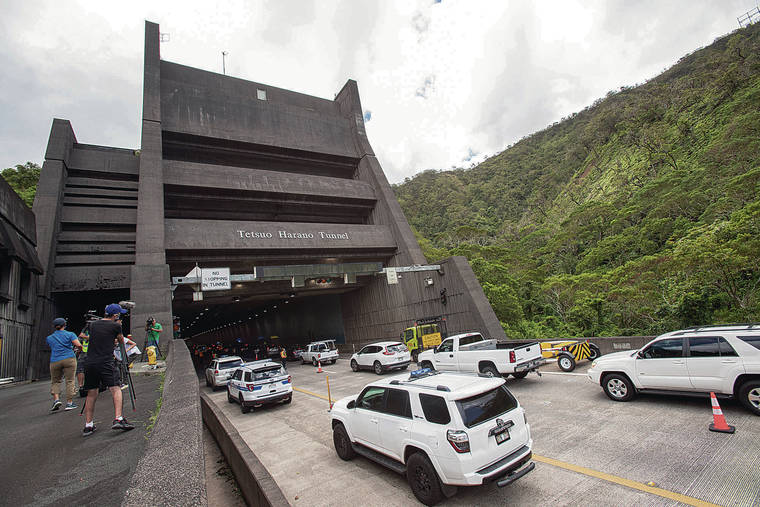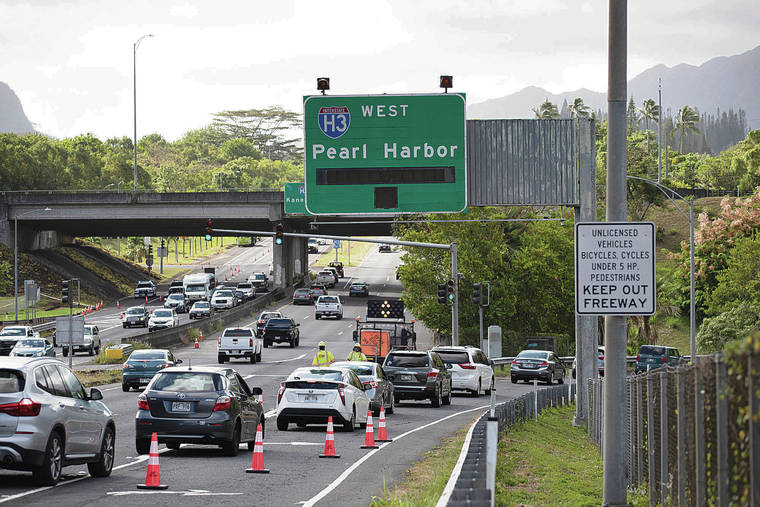Feds spurn COVID-19 testing held on H-3 freeway


CINDY ELLEN RUSSELL / CRUSSELL@STARADVERTISER.COM
H-3 Freeway was closed Tuesday for COVID-19 surge testing.

CINDY ELLEN RUSSELL / CRUSSELL@STARADVERTISER.COM
Cars entered H-3 Freeway at 8:30 a.m. Tuesday for COVID-19 surge testing in the Tetsuo Harano Tunnel.



Thousands were tested for COVID-19 Tuesday during Oahu’s unprecedented surge testing event on the H-3 freeway.
But Hawaii officials acknowledged facing the potential loss of federal transportation funding after the Federal Highways Administration denied the state’s request to use the freeway for the event.
Ed Sniffen, state Highways Division deputy director, said the state was informed of the FHA’s denial in a letter that arrived just hours before the testing was set to begin but after the freeway had been shut down at 5 a.m. and personnel were beginning to move into place.
The reasons given by the federal agency: the impact on traffic, commerce, safety and Marine Corps Base Hawaii in Kaneohe.
Sniffen said he discussed the letter with Gov. David Ige.
“We decided it’s way too important for the public for us not to move forward with this testing today,” he said at a news conference just outside the H-3 tunnel, the epicenter of Tuesday’s testing.
Don't miss out on what's happening!
Stay in touch with breaking news, as it happens, conveniently in your email inbox. It's FREE!
“We believe this is a safer testing site,” Ige said.
>> PHOTOS: COVID-19 testing held on H-3 Opens in a new tab
Opens in a new tabSniffen said he was to blame for not giving federal officials enough information about the gravity of the situation. He said the fact that Hawaii is hitting consistent triple-digit daily COVID-19 cases is “phenomenally huge.”
“I didn’t get that across to them,” he said. “I didn’t give them enough information for them to understand the big impacts.”
The state receives $180 million for projects from the FHA each year, Sniffen said, and the agency could choose to withhold some of the money.
A spokesman of the FHA in Washington, D.C., declined to discuss the situation with the Honolulu Star- Advertiser but he did issue this statement:
“The Federal Highway Administration communicates directly with our State partners and Hawaii DOT is aware of the agency’s position. We look forward to working with the State to identify alternative options.”
However, Sniffen said the state is still planning to hold the second scheduled surge testing on the H-3 freeway on Thursday.
Meanwhile, state Department of Health officials on Tuesday said they recorded four new coronavirus- related deaths and 181 new cases, bringing the statewide totals since the start of the pandemic to 74 fatalities and 8,653 cases.
The deaths included three Oahu residents and a man over the age of 80 who lived at the Yukio Okutsu State Veterans Home in Hilo, the third COVID-19-related death tied to a cluster there.
The Oahu victims were described as a man and a woman in their 70s and a man over the age of 80. All of them were hospitalized before dying, and they had underlying medical conditions.
No other information was provided.
More than 4,000 people were tested for Tuesday’s case tally, with a positivity rate of 4.5% — a lower daily rate than the state has seen in recent weeks.
“That’s good news,” said Lt. Gov. Josh Green, an emergency room doctor. “That means the virus will begin to subside.”
Green cautioned, however, that he anticipates cases will continue to surge and be active for the next 10 days before the epidemic calms down. That’s when “we’ll be able to reopen the state,” he said.
Over at the H-3 freeway, there was a steady line of cars before noon coming from town. The wait time was estimated to be as long as 45 minutes.
On the other side of the Koolau mountains, the traffic for testing was light to nonexistent other than during the first hour. At 11:30 a.m., no cars were lined up outside the tunnel on the Windward side, and only about 50 cars were inside for testing and registration.
Honolulu Fire Department Capt. Jeff Roache said pre-registration for Tuesday’s surge testing had dipped, with only 1,700 people signing up by 7 a.m.
By the midday news conference, he was imploring people to come out for an afternoon COVID-19 test.
“It’s a beautiful view,” Roache said in the sunshine. “I don’t think you’ll ever get this opportunity to see the H-3 the way you can see it today.”
The operation appeared to be running smoothly, but the experience wasn’t perfect for everyone.
One woman said she waited for over 45 minutes before reaching the tunnel and getting the test kit in a bag. But she was told to stay in the left lane. Workers kept waving her along — right back onto the open highway. She ended up leaving without getting her test completed.
Regarding the dispute with the Federal Highways Administration, Sniffen said his staff had been working with the agency for nearly a week trying to obtain permission for use of the freeway “for nontransportation purposes.”
State officials also heavily publicized the event for days, saying it was the ideal way to conduct mass testing without causing traffic disruptions in surrounding neighborhoods. They said they believed the green light from the feds would come.
Sniffen said he would continue to seek permission in advance of Thursday’s event from 9 a.m. to 2 p.m. on the H-3.
He said he hopes to explain that traffic has lessened dramatically during the 14-day Oahu lockdown, with 40,000 fewer trips between Honolulu and the Windward side and easy alternate routes.
Safety concerns are also minimized, he said, with more than 300 personnel on the scene, including 50 health care workers, 100 firefighters, 100 Air National Guard troops and 50 Honolulu police officers for traffic control.
“To shut down the entire freeway, we needed the numbers, so we brought in those numbers,” Roache said.
The total budget for the event was over $10 million, which came from the state’s allotment of federal CARES Act emergency coronavirus money, he said.



